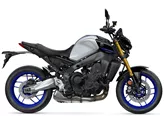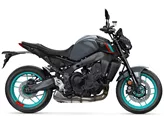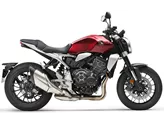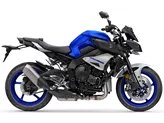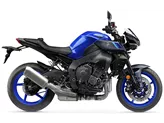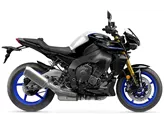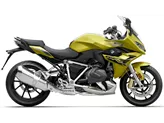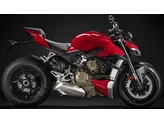Yamaha MT-09 2017 vs. Yamaha MT-10 2016

Yamaha MT-09 2017

Yamaha MT-10 2016
Vue d’ensemble - Yamaha MT-09 2017 vs Yamaha MT-10 2016
The Yamaha MT-09 model year 2017 and Yamaha MT-10 model year 2016 are both naked bikes that offer powerful performance and advanced rider assistance systems. However, there are notable differences between the two models.
In terms of engine specifications, the Yamaha MT-09 2017 is equipped with an in-line 3-cylinder engine that produces 115 HP of power and 87.5 Nm of torque. On the other hand, the Yamaha MT-10 2016 features an in-line 4-cylinder engine that delivers a higher power output of 160 HP and torque of 111 Nm. This makes the MT-10 more powerful and suitable for riders looking for a high-performance bike.
Both models come with fuel injection systems and liquid cooling for efficient and reliable performance. The Yamaha MT-09 has a displacement of 847cc, while the MT-10 has a larger displacement of 998cc, offering more power and torque.
In terms of suspension, both bikes feature upside-down telescopic forks at the front and swing arm suspension with a monoshock at the rear. This ensures a comfortable and stable ride for both models. The Yamaha MT-09 2017 has an aluminum frame with a twin tube design, while the MT-10 2016 features an aluminum frame with a Deltabox design. The Deltabox frame provides better rigidity and handling, making the MT-10 more agile and stable at high speeds.

Yamaha MT-09 2017
Both models come with double disk brakes at the front, but the Yamaha MT-10 2016 has larger diameter disks (320mm) compared to the MT-09's 298mm disks. This gives the MT-10 stronger braking power, enhancing its overall performance and safety.
In terms of dimensions and weights, the Yamaha MT-09 2017 has a front tire width of 120mm and a rear tire width of 180mm, while the MT-10 2016 has a front tire width of 120mm and a rear tire width of 190mm. Both bikes have a 17-inch front and rear tire diameter. The wheelbase of the MT-09 is 1440mm, while the MT-10 has a slightly shorter wheelbase of 1400mm. The seat height of the MT-09 is 815mm, while the MT-10 has a slightly higher seat height of 825mm. The kerb weight of the MT-09 with ABS is 193kg, while the MT-10 weighs slightly more at 210kg.
In terms of rider assistance systems, both models come with ABS and traction control, ensuring enhanced safety and control. The Yamaha MT-09 2017 also features a quickshifter, which allows for seamless gear changes without using the clutch.

Yamaha MT-10 2016
In terms of strengths, the Yamaha MT-09 2017 offers an Öhlins suspension upgrade, improved optics and sound with Akrapovic exhaust, a divine braking experience with the Magura HC3 radial brake pump, and grandiose aesthetics with Carbon2Race covers. The combination of the seat, footrests, and handlebar clamps also provides an effective riding position.
On the other hand, the Yamaha MT-10 2016 is praised for its CP4 engine, which offers a strong character and unmistakable sound. It is also highly agile and provides excellent high-speed stability. The MT-10 features strong brakes, ensuring reliable stopping power.
However, the Yamaha MT-09 2017 has some weaknesses, including a higher financial outlay and more working time required for certain parts. Additionally, the ECU Flash is not road legal. The Yamaha MT-10 2016 has limited comfort, limited wind protection, and a hard fit.
In conclusion, the Yamaha MT-09 2017 and Yamaha MT-10 2016 are both powerful naked bikes with advanced features. The MT-10 offers higher power and torque, along with a more rigid frame and larger brakes. The MT-09, on the other hand, offers upgrades in suspension, aesthetics, and braking. Both models have their strengths and weaknesses, and the choice between them depends on the rider's preferences and priorities.
Caractéristiques techniques Yamaha MT-09 2017 par rapport à Yamaha MT-10 2016
Avantages et inconvénients en comparaison
Avantages et inconvénients en comparaison
Yamaha MT-09 2017

En conclusion, après plusieurs arrêts tout au long de la saison, je peux dire que le résultat est excellent. Notre MT-09 est parfaite, tant en termes de performances que d'esthétique. Le châssis a probablement été notre point le plus important. Alors qu'il y avait auparavant beaucoup (trop) de mouvement à l'arrière dans les virages rapides, il a été repassé sans sourciller. L'amortisseur STX 46 monté est assez ferme dans sa conception de base, mais il se débrouille sans problème au quotidien sans être désagréable. Grâce aux possibilités de réglage généreuses, il y a de toute façon encore de la marge pour les préférences individuelles et l'utilisation. La fonction de la cartouche NIX 30 est également impressionnante. La réactivité s'est nettement améliorée, surtout en charge. De même, il y a maintenant beaucoup plus de réserve disponible lors du freinage sur piste. Là où, avec le réglage d'origine, la fourche se bloquait et déclenchait l'ABS en cas de freinages violents, le freinage se poursuit désormais efficacement. De plus, la MT-09 suit désormais la ligne visée dans le rayon de virage comme si elle était seule - un vrai plaisir. La vue et le son du système complet Akrapovic sont également un pur plaisir, et le fait qu'il en résulte encore quelques chevaux de plus se ressent surtout dans le tiers supérieur du régime. La roue avant s'élance encore plus volontiers dans la galerie en 2e et 3e vitesse.
Yamaha MT-10 2016

La MT-10, courte et trapue, est la plus éloignée de la superbike R1, tant au niveau de l'esthétique que du châssis, mais le cœur de la MT-10 est directement issu de l'arme de la piste de course et fascine par sa sonorité brute unique et sa force d'attaque par le bas grâce au décalage typique des tourillons qui, avec une séquence d'allumage modifiée, lui confère ce caractère unique. Les 160 ch qui en résultent ne semblent donc que sur le papier un peu faibles par rapport aux plus de 200 ch de la R1, mais en réalité, la MT-10 déclenche elle aussi un feu d'artifice incroyable. Le châssis serait probablement trop souple pour la piste de course, mais il est tout à fait adapté à un combat sur route et le freinage fait de même - acceptable pour la piste, mais parfait pour la route.
Comparaison des prix Prix moyen du marché Yamaha MT-09 vs Yamaha MT-10
There are a few key differences between a Yamaha MT-09 2017 and a Yamaha MT-10 2016. In terms of price, the actual average price of a Yamaha MT-10 2016 is about 24% higher. A Yamaha MT-09 2017 experiences a loss of 810 USD in one year and 1,050 USD in two years of ownership. This is offset by a loss of 800 USD and 1,840 USD for a Yamaha MT-10 2016. Compared to Yamaha MT-10 2016 there are more Yamaha MT-09 2017 bikes available on the 1000PS.de Marketplace, specifically 10 compared to 7. It takes less time to sell a Yamaha MT-09 with 73 days compared to 97 days for a Yamaha MT-10. Since model year 2013 1000PS.de editors have written 57 reviews for the Yamaha MT-09 and 32 reviews for the Yamaha MT-10 since model year 2016. The first review for the Yamaha MT-09 was published on 6/10/2013 and now has more than 39,900 views. This compares to more than 20,700 views for the first review on Yamaha MT-10 published on 11/17/2015.


